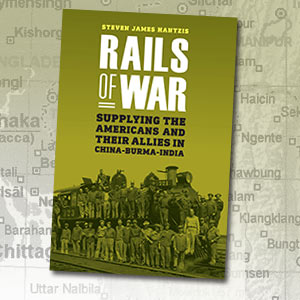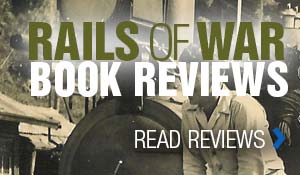Tough Guys
Tough Guys
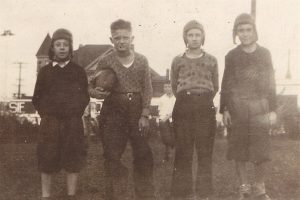
Jim Hantzis, 2nd from left, Mary O’Donnell’s brother, Chuck, far right. Circa 1931, Indianapolis
Veterans Day brings to mind a theme that pops up at every author presentation I make. It goes like this, “My relative (dad, uncle, grandfather, cousin) served in World War II, but he never talked about it.” I think I know why. When I was a young man, my father told me that “The tough guys never have to tell you how tough they are.” This, I believe, was a widely held masculine norm in his generation. A norm that many of today’s public figures would do well to embrace.
The war was tough, no matter where you served. Some had it tougher than others, no doubt, but the norm held sway. In today’s culture of Facebook celebrity and political overstatement, instant gratification, and the pathetic pursuit of “likes,” talking about one’s toughness, indeed, flouting one’s self-declared toughness, has all but swamped our more composed natures. Damaged role models abound. I prefer the quiet composition of my father’s generation and knowing that the tough guys never have to tell you how tough they are.
The following vignette was edited from Rails of War. My author’s draft was one thousand pages and two volumes. This didn’t make the cut. Still, I think this short story might be of interest to those who wonder why their loved one never talked about the war. Reticent loved ones weren’t deficient, they were likely more composed and actualized than the blowhards we are bombarded by today, in my humble opinion. So, what follows is a true story about Jim Hantzis, Jim O’Donnell, Mary Hantzis and Mary O’Donnell, their kids, a pet dog, and rabbits. Oh, and the USS Indianapolis and the atomic bomb. I hope you enjoy.
When I was a young boy on our farm in Indiana, my father hunted rabbits with his best friend, Jim O’Donnell. They’d stalk the fields, fencerows, frozen plow furrows and woods with determination and dexterity. Both men were pretty good shots. You could say that Jim O’Donnell was a bit over-qualified for shooting rabbits since he had been a Weapons Technician Grade Three in the U.S. Navy during the war.
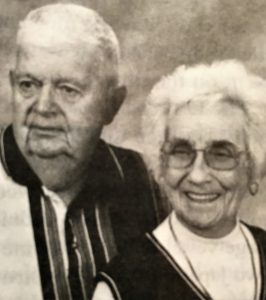
Jim and Mary Alice O’Donnell
Jim O’Donnell would drive out from Indianapolis with his wife and two sons, Tommy and Jim, and the grownups would organize an expedition, a not-so-big game foray, into the far reaches of our humble forty-acre farm. The Marys, Jim O’Donnell’s wife’s name was Mary as well, Mary Alice to be exact, would stay inside in our old farmhouse in the relative warmth of the oil-burning space heater and cook fried chickens, freshly dead after a mortal encounter with my neck-ringing, farm-girl mother, and mash the best potatoes on the planet. If the hunters were successful, the Marys would fry the rabbits as well.
When the Hantzis and O’Donnell families got together, there was salutary efficiency. There were three Jims, two Marys, two Toms, and one Steve. Four names for eight people.
The hunt would begin just behind our garage and fan out to all of the nearby farm buildings. The smokehouse, barn, and corncrib were built on fieldstone foundations. That’s the construction technique where a big rock is used to set a corner post, and the entire structure rises dependent upon the rock not settling too far. Poured-concrete foundations were still on the wish list when previous owners put up the outbuildings on our farm.
The good thing about a big rock foundation is that it allows all sorts of critters to live under the structure where they can eat grain and whatever falls between the inevitable cracks in the floor. Rabbits were one such critter. Besides being dead rabbit-totters, the boys were rabbit flushers as well. The advantage to using the boys was that the boys didn’t suffer from the family dog, Sky King’s, bad habits. The boys never chased the rabbit until it was full of buckshot, unlike Sky King. Also, the boys understood a few more commands than Sky King.
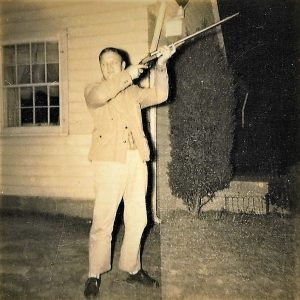
Jim Hantzis with 1925 LC Smith Field-Grade Featherweight
And by the way, here’s a tip for eating rabbit harvested by a shotgun. Watch out for buckshot! You never get all of the shot out when you clean the little critter and lead is really difficult to chew. Buckshot is hell on teeth no matter how much tug of war you play with the family dog.
It would take a couple hours to work the usual hunting areas. Then we’d return home, take off our muddy clothes and boots in the semi-heated utility room and make a beeline for the space heater in the living room. If we’d bagged some rodents, the final outdoors activity was to nail their hind feet to a board on the side of the garage, gut them and strip the fur off them. I remember being surprised that removing the skin from a rabbit was so easy. Dad would deliver the carcasses to mom, and she’d plop them into cold saltwater to draw the blood out. Then, she’d carve up the little bodies, and there are only a couple of meaty pieces on a wild rabbit, douse them in baking flour and cornmeal and fry the heck out of them. They were delightful.
During the meal and afterward, the men and the Marys would talk about adult stuff, and the boys would be boys. When it wasn’t freezing cold outside, we’d go poke around farm implements and build straw forts in the haymow. Dad and Jim O’Donnell were lifelong buddies and Arsenal Technical High School classmates and graduates. They always had a lot of catching up to do. After the war, Jim O’Donnell became an Indianapolis fireman. When dad returned from India, he continued working for the New York Central for a few years then got hired as a machinist for GM Detroit Diesel Allison Division in 1950. Both men worked as many hours as possible, took few vacations, and lived far apart, so they didn’t visit very often.
Jim O’Donnell had seen action courtesy of the U.S. Navy in World War II. He had served, logically enough, on the ill-fated USS Indianapolis. For those who may not know the distressing and curious story of the USS Indianapolis, I’ll offer this very brief version.
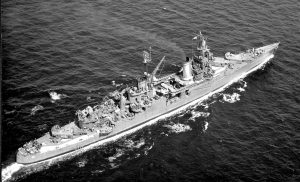
USS Indianapolis underway at sea 1943-44
The USS Indianapolis was a Treaty Cruiser built in conformance to the Washington Conference Treaty following World War I. She was designated CA-35 in the Navy’s inventory. Her keel was laid in late March 1930 under the covered ways of the New York Ship Corporation located on the Delaware River in Camden, New Jersey. Later, during the 1940s, this facility would become the world’s largest private shipbuilding facility employing more than 35,000 workers. The Indianapolis was launched November 7, 1931. Following her final fitting-out, she was commissioned by the Navy on November 15, 1932, at the Philadelphia Navy Yard.
The ship was considered a technological marvel, and she was the pride of the Navy. She was over 610 feet in length and 66 feet at the beam. She was designed for a flank speed of 32 knots. She was equipped with eight White-Forster boilers that turned four Parsons geared turbines. She had four screws and was rated at 107,000 horsepower.
She was armed with nine 8-inch guns in three turrets and four 5-inch guns. She also carried twenty-four 40mm medium range guns and thirty-two 20mm Oerlikon guns.
Following her shakedown deployment, in July 1933, the Indianapolis steamed to Bar Harbor, Maine to pick up President Franklin Roosevelt at his Campobello Island summer home and take him to Annapolis, Maryland. Thus began her long and distinguished role as a Ship of State and chosen transport for dignitaries and the president.
On December 5, 1941, the Indianapolis was ordered out of Pearl Harbor on an unusual and unexpected exercise to simulate bombardment of Johnson Island. The ship was given one hour’s notice and ordered out to sea with a third of her crew. Otherwise, the USS Indianapolis would have been moored to the Mine Dock at Pearl when the torpedoes began to fall.
This is where the curiosity begins. The Indianapolis was, after all, the president’s favorite ship and the flagship of Admiral Wilson Brown, head of Scouting Force. It was as if someone knew something was brewing.
With the outbreak of war, the Indianapolis saw her first combat some 350 miles south of Rabal, New Britain in February 1942. She was subsequently sent to the Aleutian Islands. In the spring of 1943, she became the Flagship for Admiral Raymond Spruance, Commander, Fifth Fleet. Admiral Spruance had won the naval battle at Midway.
On March 31, 1945, a Japanese Kamikaze flew into the USS Indianapolis during the battle for Okinawa. The plane didn’t do much damage but the bomb the plane released just before crashing penetrated armor on the port quarter and continued down through the crew’s mess, a berthing compartment, the fuel tanks and through the ship’s hull, exploding somewhere below the boat. The attack killed nine and injured twenty-six.
This attack and the resulting damage set in motion a series of events that would place the USS Indianapolis at the center of the worst single disaster at sea ever suffered by the U.S. Navy. Because of her damage, she was ordered to Mare Island, Vallejo, California, for extensive repairs in dry-dock. She arrived in late April 1945.
At 5:29:45 a.m. Mountain War Time on July 16, 1945, the sand of Alamogordo, New Mexico turned to glass. The conversion took less than a second and prompted Robert Oppenheimer to quote from the Hindu Bhagavad Gita, “I am become death, the destroyer of worlds.”
Those present and all forms of Gods in their Heavens had witnessed the first plutonium implosion, nineteen kilotons of Atomic Bomb. So, in the golden, purple, violet, gray, and blue morning sky lit by man’s first manufactured sun people suspended disbelief awestruck by their species’ tool-making achievement. But the military and political bureaucracy never sleeps and never tires, and was that very moment conjuring a way to get the new tool to where it could do some real good, or evil, depending upon which end of the device one found oneself.
Early that same morning, as fallout was raining on the molten glass wasteland of New Mexico, an outsized entourage of admirals, generals, technicians, and guards stood pier-side watching atomic bomb components being loaded aboard the USS Indianapolis. Wooden crates were stowed in the ship’s hangars and the uranium-235 for two bombs, sealed in a lead-lined metal container, was lashed to cleats then tack-welded to the deck in the Admiral’s Cabin. If this addition wasn’t sufficient cause for speculation by the uninformed crew, including Captain Charles McVay, strict orders were given that should the ship come under attack and find herself in extremis, the lead container was to be immediately jettisoned. And with that, the Indianapolis was off and running to Tinian in the Western Pacific.
The swift ship delivered her deadly tool in a record-setting run that averaged 29 knots. This included a six-hour stop at Pearl Harbor to refuel and replenish. It took less than ten days to cover the 5,300 nautical miles from California. A few days later, the Enola Gay B-29 bomber, flying at 31,060 feet, released the tool which promptly plummeted to its final destination 1,850 feet above Hiroshima, Japan. As the tool went about its business of converting matter to energy, 66,000 were killed instantly, and any sand in the vicinity was turned to glass. Another 74,000 died soon after that, and the Japanese began to rethink their war ambitions.
After delivering the bomb, the Indianapolis was sent south to Leyte Gulf on the East Coast of the Philippines. Some 1,500 nautical miles west of Guam, the fated ship was to join the USS Idaho for gunnery practice and refresher training. During its stop in Guam, a single coded message was sent to the Idaho about the rendezvous. The official record shows that the message was garbled on the receiving end and there was no request to repeat. So, the Idaho had no reason to expect the Indianapolis.
The Indianapolis steamed out of Guam on July 28, 1945, at a moderate 15 knots. When the watch changed at midnight July 29, the Indianapolis was making 17 knots bearing 262 degrees and secured from zigzagging. The fact that they weren’t zigzagging would play heavily into the future legal problems of Captain McVay.
Just after midnight, below the deceptively peaceful surface of the Western Pacific, Lieutenant Commander Mochitsura Hashimoto, positioned his 2,140-ton submarine, I-58, to launch a spread of torpedoes at the Indianapolis. Hashimoto selected to use conventional armaments although his boat had been modified to fire the 48-foot Kaiten manned torpedo and he had six weapons and their pilots onboard.
His first torpedo loaded with 1,200 pounds of Shimose powder struck and blew away the bow of the Indianapolis. The second hit starboard near a powder magazine and one of her fuel oil bunkers. The second explosion knocked out all electricity including radio transmitters. The radiomen onboard testified later that they had transmitted at least three S-O-S messages before power was lost.
In about twelve minutes, the ship rolled to port and went down bow first. Of the 1,197 souls aboard an estimated 880, many mortally wounded, burned and maimed, made it into the inky, oil-slicked waters alive. Their hapless bodies floated without provisions, no water, no food, very few life jackets, and even fewer rafts, scattered over thousands of yards of ocean. By the time they were rescued, they would be spread over twenty miles of water gathered in small clusters of floaters and rafters.
The next morning, as the sun peeked above the horizon, sharks began to pick-off men floating on the perimeter of clusters. Their screams were muffled only when water filled their lungs.
But surely, the survivors reasoned, their rescue would come quickly. The Indianapolis was, after all, the flagship of the Fifth Fleet. The USS Idaho was expecting them, and a search would surely commence shortly. So the floating, vulnerable, dehydrated, burned and shocked survivors hoped for the best but marshaled what provisions they had and planned for the worst.
Their flickering and faint hopefulness began to die along with more and more men on the second day in the water. By the third day, lack of food and fresh water and the remorseless terror from below pushed men beyond their limits. Dying of thirst, men began to drink the salty ocean water. Once they started drinking the salt water, their demise was inevitable, and the other men in their group would push them away to float alone. When the end came, the survivors retrieved their lifejacket and said the Lord’s Prayer as their body was set loose to drift below the unforgiving sea.
Hallucinations replaced reality and fights broke out. At the end of the third day, only four hundred men were still alive. Their lifejackets were waterlogged and losing their buoyancy, and the bodies of the dead floated alongside the living. All would have died, including dad’s buddy Jim O’Donnell the Indianapolis fireman, if it hadn’t been for a tool not quite so well designed as the atomic bomb.
On the fourth day, at about 1025 hours, Lieutenant Chuck Gwinn was piloting his Ventura PV-1 bomber out of Palau, about three hundred miles south of where the Indianapolis went down. He was on a routine antisubmarine patrol, his second of the day.
The tool that was giving his crew difficulty was a faulty antenna winch with a binding problem. So, Lieutenant Gwinn found himself leaning out of the plane, guiding the wire antenna when he saw what looked like a sizable oil slick. Believing the oil slick to be from a recently submerged submarine attempting to hide from his plane, he put the Ventura into a descent path and began a depth charge run. As he ordered the bomb bay doors open, he glanced once more at the ocean and to his astonishment saw hundreds of delirious men waving at him.
The young lieutenant immediately regained altitude and radioed Palau for help. His message was “Many men in the water,” and he gave his longitude and latitude. The Navy initially thought it was a prank and waited for confirmation. In the meanwhile, Lieutenant Gwinn descended and threw all the survival gear in his aircraft overboard for the desperate men below.
Three hours after his first broadcast, a Catalina PBY flying boat was dispatched with a twenty-eight-year-old pilot from Frankfort, Indiana at the controls. En route to the survivors, Lieutenant Adrian Marks overflew the USS Cecil Doyle and radioed its captain. He told the captain of his mission and of his own initiative Graham Claytor diverted the craft from its ordered course to aid in the rescue.
When Marks arrived, he dropped the PBY to about 100 feet and began offloading rafts and supplies. While throwing the items overboard, the crew reported that they saw men being attacked by sharks. The PBY’s crew voted to abandon standing orders and land on the roiling open sea in their relatively frail amphibious airboat. Such a landing was entirely against regulations and standing orders. But the brave men made a selfless humanitarian decision and put at risk their own lives without knowing the nationality of the men in the water. They could have been Japanese for all they knew.
They approached between swells in a power stall, tail-low, nose-high attitude. The PBY took a beating, popping rivets out of its hull and jarring the brave crew, but landed in one piece. Marks taxied to the nearest group of men and began taking survivors onboard. The PBY’s crew helped the ones with enough strength to swim to the plane and lugged the weary men onto the fabric wings of the aircraft. The PBY would never fly again, but it saved fifty-six men that night.
The USS Cecil Doyle, Talbot, and Dufilho converged on the survivors and eventually pulled 317 men from the water, 317 out of 1,197. That’s about a one-in-four chance of survival, and Jim O’Donnell beat the odds. Jim would put his good fortune to good use and return from the war to marry Mary and raise a wonderful family. He was eventually named “Man of the Year” by the Indianapolis Star in 1996 for his efforts on behalf of the survivors and his role in constructing an officially recognized memorial in Indianapolis to the USS Indianapolis.
Captain McVay was court-martialed for “hazarding his vessel by failing to zigzag.” Although the conviction stayed on his record until 2001, well after his death, Admiral Chester Nimitz remitted his punishment in 1946.
Captain McVay was able to continue his Navy career, but his life did not unfold well, and in 1968 he committed suicide. He was found with his .38-caliber service revolver in one hand and a toy sailor attached to a key ring in the other. After his trip to the United States to testify at McVay’s court-martial, Hashimoto spent the rest of his ninety-one years in Kyoto, Japan as a Shinto Priest pursuing no longer enemy ships but the way of the kami.
The sinking of the Indianapolis was big news on Tinian. At 0130 hours on August 6, 1945, the men of the Enola Gay scrawled “A present for the souls of the Indianapolis crew,” on the tool they would deploy at 0815 hours to 1,850 feet above Hiroshima.
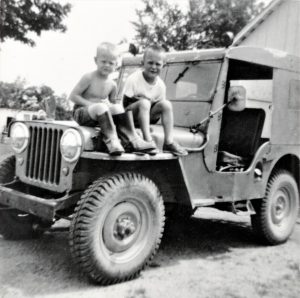
Tom & Steve Hantzis, Circa 1955
As we sat around the Formica-top, chrome trimmed kitchen table eating fried chicken and rabbits, the boys kneed each other and giggled when my brother ate his mashed potatoes with a celery stick. The men talked about…whatever. And that’s the thing. I don’t recall Jim and Jim talking about the war. And believe me, war stories would have been soaked up by the boys like gravy on white bread. I think the Jims talked about work and old friends and made inside jokes with the Marys. I’m sure they talked about cars, football, and basketball as well.
So, Jim O’Donnell and Jim Hantzis would talk about boring subjects, the boys would haul the rabbits and occasionally get a thrill ride in dad’s 1949 four-wheel-drive jeep, and the Marys would talk about life on the farm, life in the city, old friends and the intricacies of raising boys. Our get-togethers were perfectly regular, predictable and wholesome occasions and I wish like hell I could listen in to one of them today. But as mom use to say, “If wishes were horses, we all could ride.”
If I could listen in today, it would still be a long shot that I might hear Jim O’Donnell talk about the USS Indianapolis. He told a local publication a few years back, “Everybody just wanted to put the experience in the past. It was always there, but you never talked about it.” I would probably have heard a lot of talk about how good the potatoes were or how some rabbit out-foxed one of the Jims. It’s likely the tough guys would never have said how tough they were. – © 2008 Steven James Hantzis


